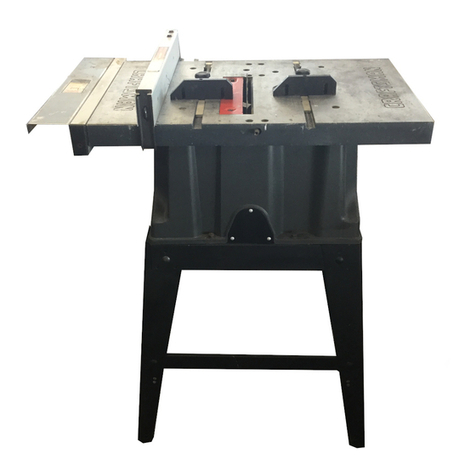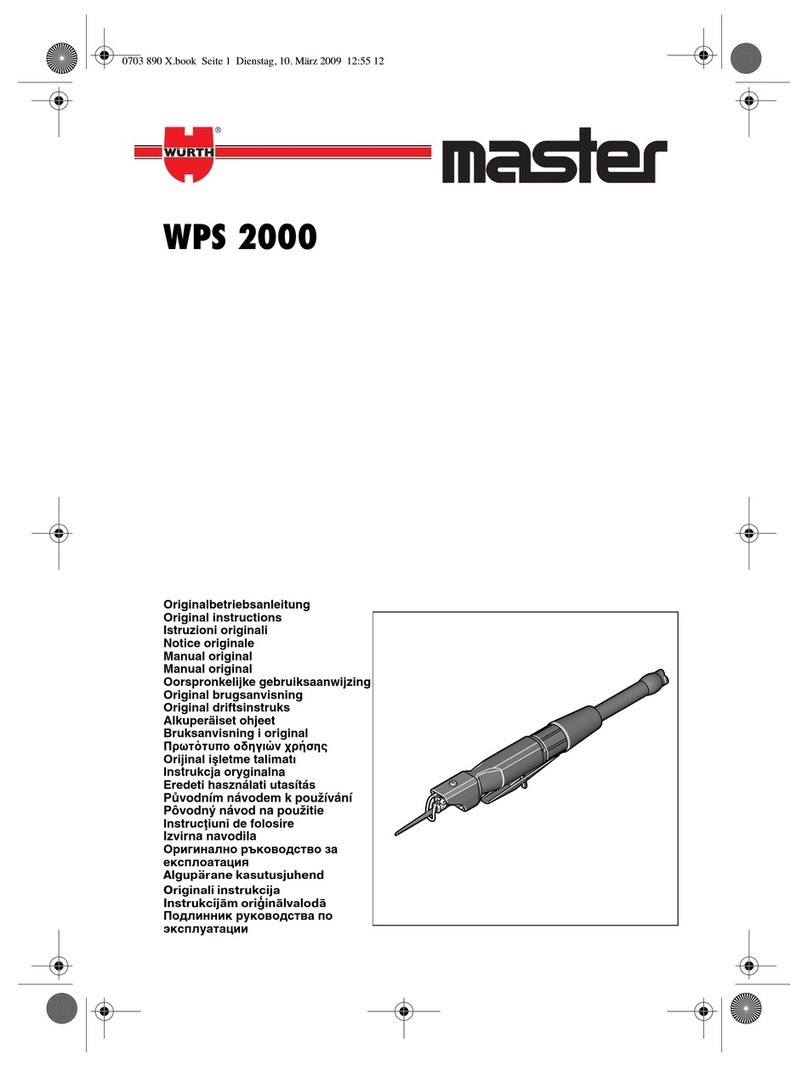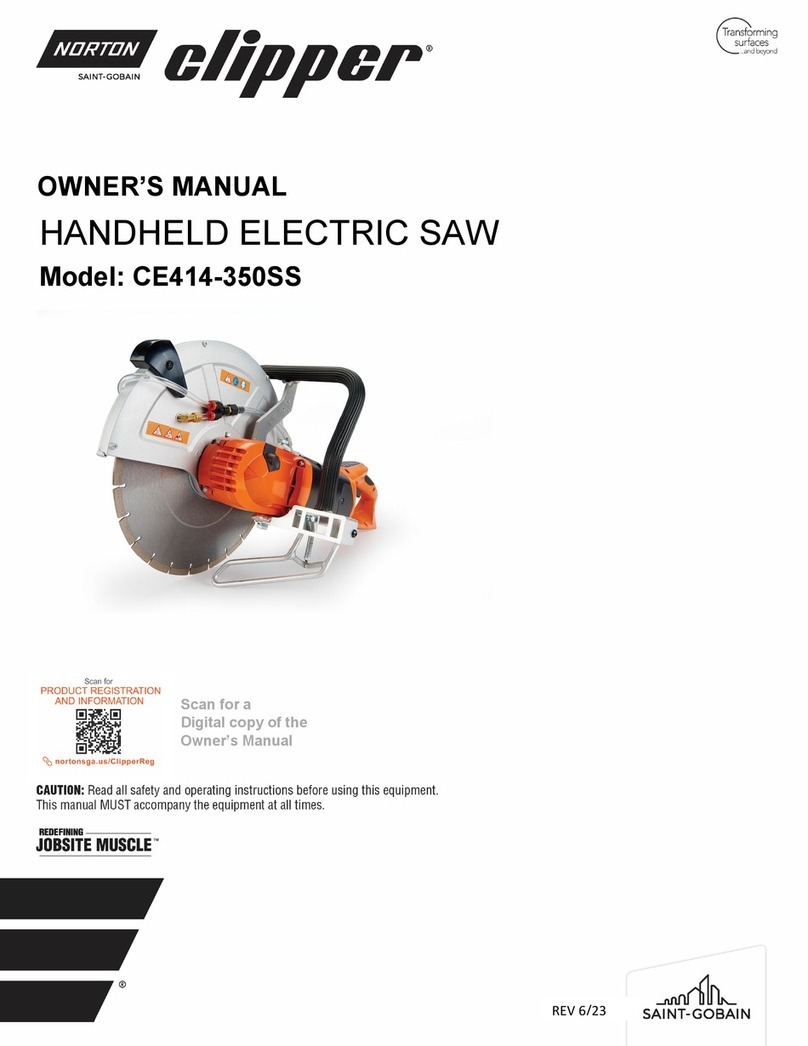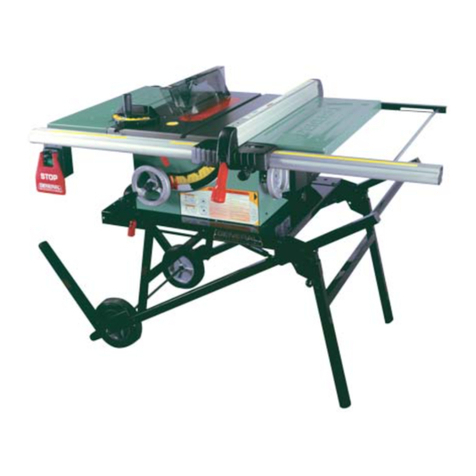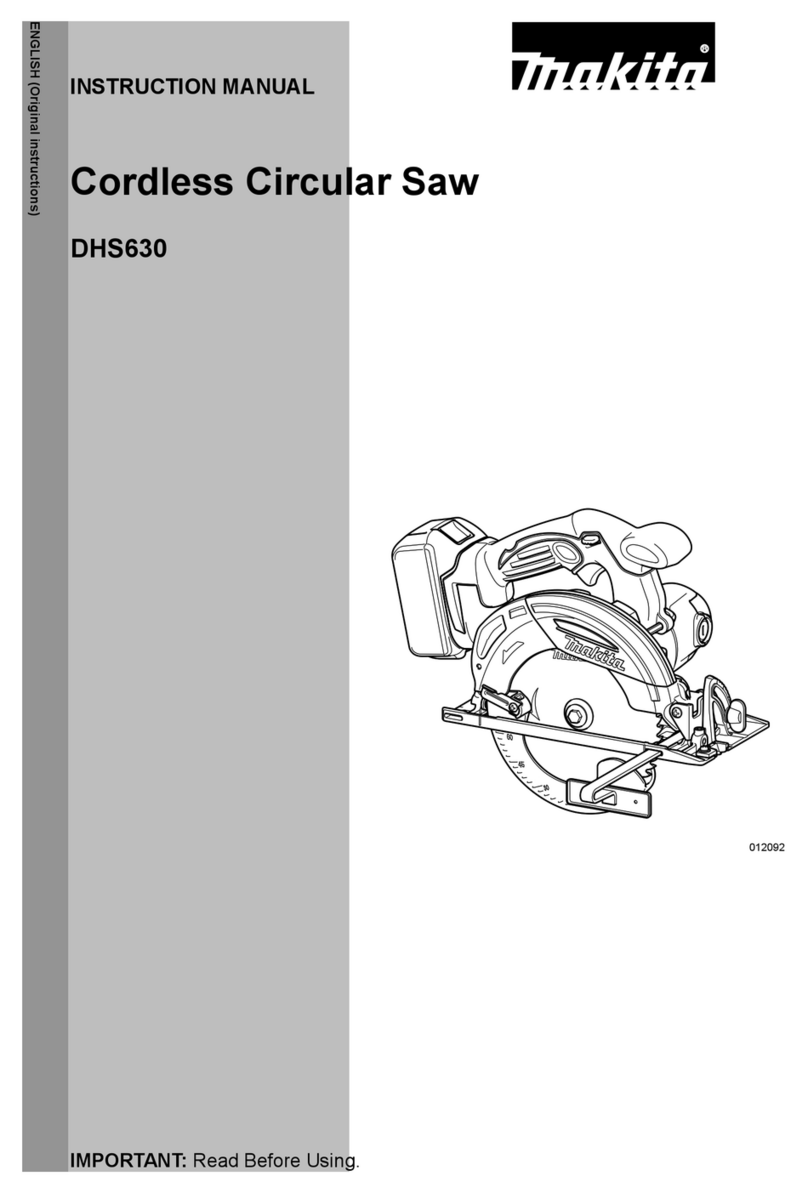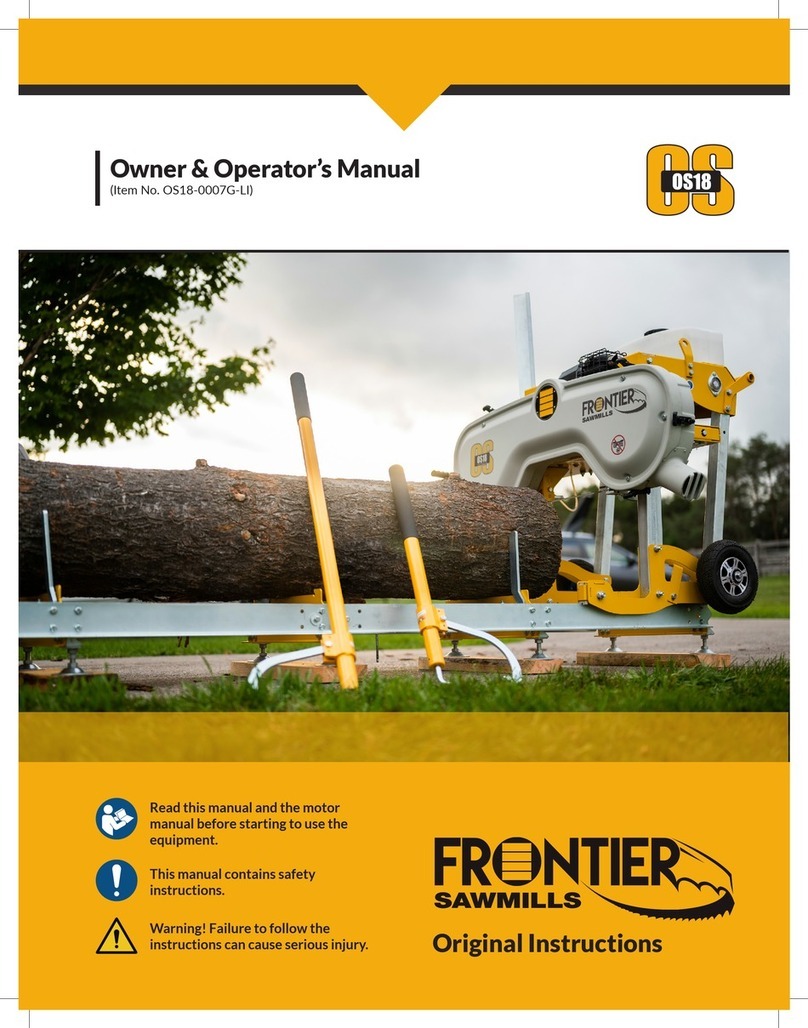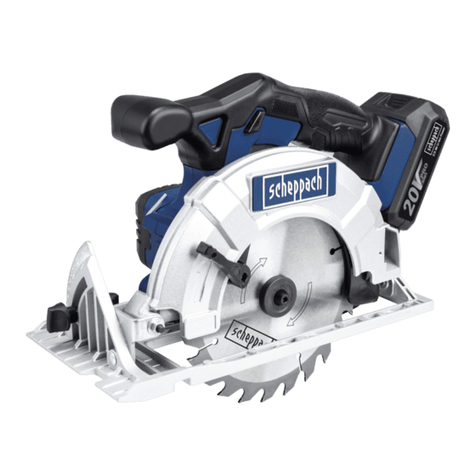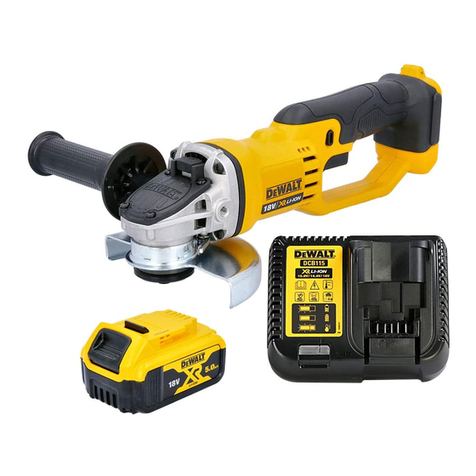Woods ALITEC PS9 1.5MD User manual

OPER ATOR'S MANUAL
MPS9
SKID STEER
PAVEMENT SA W
PS9 1.5MD
PS9 2.5MD
PS9 4.5MD
PS9 1.5HD
PS9 2.5HD
PS9 4.5HD
PS9 1.5HD SINGLE CIRCUIT
PS9 2.5HD SINGLE CIRCUIT
Effective Serial Number:
550020201 PS9 2.5HD
(Rev. 6/27/2019)

2 Introduction Gen’l (Rev. 2/25/2016)
TO THE DEALER:
Assembly and proper installation of this product is the responsibility of the Woods® dealer. Read manual instructions
and safety rules. Make sure all items on the Dealer’s Pre-Delivery and Delivery Check Lists in the Operator’s Manual
are completed before releasing equipment to the owner.
The dealer must complete the online Product Registration form at the Woods Dealer Website which certifies that
all Dealer Check List items have been completed. Dealers can register all Woods product at
dealer.WoodsEquipment.com under Product Registration.
Failure to register the product does not diminish customer’s warranty rights.
TO THE OWNER:
Read this manual before operating your Woods equipment. The information presented will prepare you to do a better and
safer job. Keep this manual handy for ready reference. Require all operators to read this manual carefully and become
acquainted with all adjustment and operating procedures before attempting to operate. Replacement manuals can be
obtained from your dealer. To locate your nearest dealer, check the Dealer Locator at www.WoodsEquipment.com, or in
the United States and Canada call 1-800-319-6637.
The equipment you have purchased has been carefully engineered and manufactured to provide dependable and
satisfactory use. Like all mechanical products, it will require cleaning and upkeep. Lubricate the unit as specified.
Observe all safety information in this manual and safety decals on the equipment.
For service, your authorized Woods dealer has trained mechanics, genuine Woods service parts, and the necessary
tools and equipment to handle all your needs.
Use only genuine Woods service parts. Substitute parts will void the warranty and may not meet standards required for
safe and satisfactory operation. Record the model number and serial number of your equipment in the spaces
provided:
Model: _______________________________ Date of Purchase: _____________________
Serial Number: (see Safety Decal section for location) ____________________________________
Provide this information to your dealer to obtain correct repair parts.
Throughout this manual, the term NOTICE is used to indicate that failure to observe can cause damage to equipment.
The terms CAUTION, WARNING, and DANGER are used in conjunction with the Safety-Alert Symbol (a triangle with
an exclamation mark) to indicate the degree of hazard for items of personal safety.

Introduction 3
MSP9 (Rev. 4/20/2007)
TABLE OF CONTENTS
INTRODUCTION . . . . . . . . . . . . . . . . . . . . . . . . . . . . . . . . . . . . . . . . . . . . . . 2
SPECIFICATIONS. . . . . . . . . . . . . . . . . . . . . . . . . . . . . . . . . . . . . . . . . . . . . 4
GENERAL INFORMATION . . . . . . . . . . . . . . . . . . . . . . . . . . . . . . . . . . . . . . 4
SAFETY RULES . . . . . . . . . . . . . . . . . . . . . . . . . . . . . . . . . . . . . . . . . . . . . . 5
SAFETY DECALS . . . . . . . . . . . . . . . . . . . . . . . . . . . . . . . . . . . . . . . . . . . . . 8
OPERATION . . . . . . . . . . . . . . . . . . . . . . . . . . . . . . . . . . . . . . . . . . . . . . . . 10
ATTACHING PAVEMENT SAW. . . . . . . . . . . . . . . . . . . . . . . . . . . . . . . 10
DEPTH ADJUSTMENT . . . . . . . . . . . . . . . . . . . . . . . . . . . . . . . . . . . . . .11
SIDESHIFT ADJUSTMENT. . . . . . . . . . . . . . . . . . . . . . . . . . . . . . . . . . .11
PAVEMENT SAW OPERATION . . . . . . . . . . . . . . . . . . . . . . . . . . . . . . 12
TRANSPORTING . . . . . . . . . . . . . . . . . . . . . . . . . . . . . . . . . . . . . . . . . 12
TROUBLE SHOOTING . . . . . . . . . . . . . . . . . . . . . . . . . . . . . . . . . . . . . . . . 14
SERVICE . . . . . . . . . . . . . . . . . . . . . . . . . . . . . . . . . . . . . . . . . . . . . . . . . . . 16
CUTTING WHEEL & GEARBOX . . . . . . . . . . . . . . . . . . . . . . . . . . . . . 16
DEPTH JACK . . . . . . . . . . . . . . . . . . . . . . . . . . . . . . . . . . . . . . . . . . . . 18
PICK . . . . . . . . . . . . . . . . . . . . . . . . . . . . . . . . . . . . . . . . . . . . . . . . . . . 18
LUBRICATION . . . . . . . . . . . . . . . . . . . . . . . . . . . . . . . . . . . . . . . . . . . 19
ASSEMBLIES & PARTS LISTS. . . . . . . . . . . . . . . . . . . . . . . . . . . . . . . . . . 21
FITTING TORQUE CHART . . . . . . . . . . . . . . . . . . . . . . . . . . . . . . . . . . . . . 32
BOLT TORQUE CHART . . . . . . . . . . . . . . . . . . . . . . . . . . . . . . . . . . . . . . . 36
BOLT SIZE CHART & ABBREVIATIONS . . . . . . . . . . . . . . . . . . . . . . . . . . 37
INDEX . . . . . . . . . . . . . . . . . . . . . . . . . . . . . . . . . . . . . . . . . . . . . . . . . . . . . 38
REPLACEMENT PARTS WARRANTY . . . . . . . . . . . . INSIDE BACK COVER
PRODUCT WARRANTY . . . . . . . . . . . . . . . . . . . . . . . . . . . . . .BACK COVER
Si no lee Ingles, pida ayuda a
alguien que si lo lee para que le
traduzca las medidas de seguridad.
LEA EL INSTRUCTIVO!
!

4Introduction MSP9 (Rev. 4/20/2007)
SPECIFICATIONS
PS9 1.5 PS9 2.5 PS9 4.5
Cutting Width 1.5" 2.5" 4.5"
Cutting Depth 9" 9" 9"
Sideshift Travel 22" 22" 22"
Recommended Hydraulic Flow 25 - 30 GPM 25 - 30 GPM 25 - 30 GPM
Recommended Hydraulic Pressure 2000 - 3000 PSI 2000 - 3000 PSI 2000 - 3000 PSI
Operating Weight 1700 lbs. 1700 lbs. 1700 lbs.
Drive Planetary Planetary Planetary
Maximum Hydraulic Pressure 3500 PSI 3500 PSI 3500 PSI
Maximum Hydraulic Flow 32 GPM 32 GPM 32 GPM
GENERAL INFORMATION
The purpose of this manual is to assist you in operat-
ing and maintaining your pavement saw. Read it care-
fully. It furnishes information and instructions that will
help you achieve years of dependable performance.
These instructions have been compiled from exten-
sive field experience and engineering data. Some
information may be general in nature due to unknown
and varying operating conditions. However, through
experience and these instructions, you should be able
to develop procedures suitable to your particular situ-
ation.
The illustrations and data used in this manual were
current at the time of printing but, due to possible
inline production changes, your machine may vary
slightly in detail. We reserve the right to redesign and
change the machines as may be necessary without
notification.
Throughout this manual, references are made to right
and left directions. These are determined by standing
behind the equipment facing the direction of forward
travel. Wheel rotation is counter-clockwise as viewed
from the right side of the pavement saw.

SAFETY 5
Alitec Pavement Saw (Rev. 3/2/2007)
INSTALLATION
Hydraulics must be connected as instructed in
this manual. Do not substitute parts, modify, or
connect in any other way.
After connecting hoses, check that all control
lever positions function as instructed in the Opera-
tor's Manual. Do not put into service until control
lever and equipment movements are correct.
TRAINING
Safety instructions are important! Read all
attachment and power unit manuals; follow all
safety rules and safety decal information. (Replace-
ment manuals and safety decals are available from
your dealer. To locate your nearest dealer, check
the Dealer Locator at www.WoodsEquipment.com,
or in the United States and Canada call 1-800-319-
6637.) Failure to follow instructions or safety rules
can result in serious injury or death.
If you do not understand any part of this manual
and need assistance, see your dealer.
Know your controls and how to stop engine and
attachment quickly in an emergency.
Operators must be instructed in and be capable
of the safe operation of the equipment, its attach-
ments, and all controls. Do not allow anyone to
operate this equipment without proper instructions.
Keep hands and body away from pressurized
lines. Use paper or cardboard, not hands or other
body parts to check for leaks. Wear safety goggles.
Hydraulic fluid under pressure can easily penetrate
skin and will cause serious injury or death.
Make sure that all operating and service person-
nel know that if hydraulic fluid penetrates skin, it
must be surgically removed as soon as possible by
a doctor familiar with this form of injury or gan-
grene, serious injury, or death will result.
CONTACT A PHYSICIAN IMMEDIATELY IF FLUID
ENTERS SKIN OR EYES. DO NOT DELAY.
Never allow children or untrained persons to
operate equipment.
PREPARATION
Check that all hardware is properly installed.
Always tighten to torque chart specifications
unless instructed otherwise in this manual.
Counterweight ballast may be required for
machine stability. Check your power unit manual or
contact your dealer.
Air in hydraulic systems can cause erratic oper-
ation and allows loads or equipment components
to drop unexpectedly. When connecting equipment
or hoses or performing any hydraulic maintenance,
purge any air in hydraulic system by operating all
hydraulic functions several times. Do this before
putting into service or allowing anyone to
approach the equipment.
After connecting hoses, check that all control
lever positions function as instructed in the Opera-
tor's Manual. Do not put into service until control
lever and equipment movements are correct.
Protective hose sleeves must cover all hydrau-
lic hoses within 20 inches of the operator and be
secured onto metal hose fittings. Replace hoses or
sleeves if damaged or if protective sleeve cannot
be properly positioned or secured.
Make sure all hydraulic hoses, fittings, and
valves are in good condition and not leaking before
starting power unit or using equipment. Check and
route hoses carefully to prevent damage. Hoses
must not be twisted, bent sharply, kinked, frayed,
pinched, or come into contact with any moving
parts. Operate moveable components through full
operational range to check clearances. Replace
any damaged hoses immediately.
Always wear relatively tight and belted clothing
to avoid getting caught in moving parts. Wear
sturdy, rough-soled work shoes and protective
equipment for eyes, hair, hands, hearing, and head;
and respirator or filter mask where appropriate.
Be sure attachment is properly secured,
adjusted, and in good operating condition. Coupler
lockpins must be fully extended and properly
engaged into attachment retaining slots.
(Safety Rules continued on next page)
Safety is a primary concern in the design and
manufacture of our products. Unfortunately, our
efforts to provide safe equipment can be wiped
out by an operatorʼs single careless act.
In addition to the design and configuration of
equipment, hazard control and accident preven-
tion are dependent upon the awareness, concern,
judgement, and proper training of personnel
involved in the operation, transport, maintenance
and storage of equipment.
It has been said “The best safety device is an
informed, careful operator.” We ask you to be that
kind of operator.
SAFETY RULES
ATTENTION! BECOME ALERT! YOUR SAFETY IS INVOLVED!

6 SAFETY Alitec Pavement Saw (Rev. 3/2/2007)
(Safety Rules continued from previous page)
Power unit must be equipped with ROPS and
seat belt/operator restraint. Keep seat belt/operator
restraint securely fastened/engaged. Falling off
power unit can result in death from being run over
or crushed. Keep ROPS systems in place at all
times.
Make sure all safety decals are installed.
Replace if damaged. (See Safety Decals section for
location.)
Make sure shields and guards are properly
installed and in good condition. Replace if damaged.
Inspect and clear area of stones, branches, or
other hard objects that might be thrown, causing
injury or damage.
OPERATION
Improper operation can cause the machine to
tip or roll over and cause injury or death.
• Keep power unit lift arms and attachment as
low as possible.
• Do not travel or turn with power unit lift arms
and attachment raised.
• Turn only on level ground.
• Go up and down slopes, not across them.
• Keep the heavy end of the machine uphill.
• Do not overload the machine.
Never use attachment to carry loads that exceed
the rated operating capacity or other specifications
of the power unit. Check your power unit manual or
see your dealer for rated operating capacity.
Exceeding this capacity can cause machine to tip,
roll over, or present other hazards that can cause
injury or death.
Do not allow bystanders within 25 feet of the
area when operating, attaching, removing, assem-
bling, maintaining, or servicing equipment.
Consult local utilities before digging. Know
location and depth of all underground cables, pipe-
lines, and other hazards in working area and avoid
contact.
Contact with high voltage, overhead power
lines, underground cables, gas lines, and other
hazards can cause serious injury or death from
electrocution, explosion, or fire.
Keep bystanders away from equipment.
Do not operate or transport equipment while
under the influence of alcohol or drugs.
Operate only in daylight or good artificial light.
Keep hands, feet, hair, and clothing away from
equipment while engine is running. Stay clear of all
moving parts.
Always comply with all state and local lighting
and marking requirements.
Do not allow riders. Do not lift or carry anybody
on the power unit or attachments.
Always sit in power unit seat when operating
controls or starting engine. Securely fasten seat
belt/operator restraint, place transmission in park
or neutral, engage brake and ensure all other con-
trols are disengaged before starting power unit
engine.
Look down and to the rear and make sure area
is clear before traveling in reverse.
Use extreme care when working close to fences,
ditches, other obstructions, or on hillsides.
Do not operate or transport on steep slopes.
Do not stop, start, or change directions sud-
denly on slopes.
Use extreme care and reduce ground speed on
slopes and rough terrain.
Watch for hidden hazards on the terrain during
operation.
NEVER GO UNDERNEATH EQUIPMENT. Never
place any part of the body underneath equipment
or between moveable parts even when the engine
has been turned off. Hydraulic system leak-down,
hydraulic system failures, mechanical failures, or
movement of control levers can cause equipment
to drop or rotate unexpectedly and cause severe
injury or death.
• Service work does not require going under-
neath implement.
• Read Operator's Manual for service instruc-
tions or have service performed by a qualified
dealer.
Before making any adjustments on attachment,
stop engine and engage parking brake. Never
adjust or work on attachment while the power unit
or attachment is running.
Before leaving operator's seat, lower lift arms
and put attachment on the ground. Engage brake,
stop engine, remove key, and remove seat belt.
MAINTENANCE
Before leaving operator's seat, lower lift arms
and put attachment on the ground. Engage brake,
stop engine, remove key, and remove seat belt.
SAFETY RULES
ATTENTION! BECOME ALERT! YOUR SAFETY IS INVOLVED!

SAFETY 7
Alitec Pavement Saw (Rev. 3/2/2007)
Before cleaning, adjusting, lubricating, or ser-
vicing this unit, always follow this MANDATORY
SAFETY SHUTDOWN PROCEDURE:
• Move the skid steer loader propulsion control
lever to the “neutral” position.
• Shut off the attachment by shutting off the
auxiliary hydraulic output.
• Lower the loader lift arms completely and roll
the attachment forward so it is securely resting
on firm ground or the shop floor.
• Engage the loader park brake.
• Move the loader throttle to the slow idle posi-
tion, shut the engine off, and remove the igni-
tion key.
• Keep the key with you at all times when work-
ing on the unit so no one can start the engine
without your knowledge.
NEVER GO UNDERNEATH EQUIPMENT. Never
place any part of the body underneath equipment
or between moveable parts even when the engine
has been turned off. Hydraulic system leak-down,
hydraulic system failures, mechanical failures, or
movement of control levers can cause equipment
to drop or rotate unexpectedly and cause severe
injury or death.
• Service work does not require going under-
neath implement.
• Read Operator's Manual for service instruc-
tions or have service performed by a qualified
dealer.
Do not modify or alter or permit anyone else to
modify or alter the equipment or any of its compo-
nents in any way.
Your dealer can supply original equipment
hydraulic accessories and repair parts. Substitute
parts may not meet original equipment specifica-
tions and may be dangerous.
Always wear relatively tight and belted clothing
to avoid getting caught in moving parts. Wear
sturdy, rough-soled work shoes and protective
equipment for eyes, hair, hands, hearing, and head;
and respirator or filter mask where appropriate.
Do not allow bystanders within 25 feet of the
area when operating, attaching, removing, assem-
bling, maintaining, or servicing equipment.
Be sure attachment is properly secured,
adjusted, and in good operating condition. Coupler
lockpins must be fully extended and properly
engaged into attachment retaining slots.
Never perform service or maintenance with
engine running.
Keep all persons away from operator control
area while performing adjustments, service, or
maintenance.
Tighten all bolts, nuts, and screws to torque
chart specifications. Check that all cotter pins are
installed securely to ensure equipment is in a safe
condition before putting unit into service.
Make sure all safety decals are installed.
Replace if damaged. (See Safety Decals section for
location.)
Make sure shields and guards are properly
installed and in good condition. Replace if damaged.
Do not disconnect hydraulic lines until all sys-
tem pressure is relieved. Lower unit to ground,
stop engine, and operate all hydraulic control
levers.
STORAGE
Follow manual instructions for storage.
Keep children and bystanders away from stor-
age area.
SAFETY RULES
ATTENTION! BECOME ALERT! YOUR SAFETY IS INVOLVED!

8 Safety MPS9 (Rev. 4/20/2007)
AVOID INJURY
OR DEATH
Bystanders must stay
6M (20 ft.) away.
Stop engine before
servicing or cleaning
this equipment.
DANGER
D0062-A
2 - D0062
WARNING
PINCH AREA
Keep clear during
operation.
D0192
7 - D0192
WARNING
FLYING OBJECT
HAZARD
Keep clear during
operation.
D0195
WARNING
FLYING OBJECT
HAZARD
Keep clear during
operation.
8 - D0195
D0209
9 - D0209
HIGH-PRESSURE HYDRAULIC OIL LEAKS CAN PENETRATE SKIN
RESULTING IN SERIOUS INJURY, GANGRENE OR DEATH.
n
Check for leaks with cardboard; never use hand.
n
Before loosening fittings: lower load, release pressure, and
be sure oil is cool.
n
Consult physician immediately if skin penetration occurs.
WARNING
19924-B
10 - 19924
SAFETY & INSTRUCTIONAL DECALS
ATTENTION! BECOME ALERT! YOUR SAFETY IS INVOLVED!
Replace Immediately If Damaged!

Safety 9
MPS9 (Rev. 4/20/2007)
MODEL NO. SERIAL NO.
Woods Equipment Company
Oregon, Illinois, U.S.A.
13 - Serial Number Plate
TO AVOID SERIOUS INJURY OR DEATH:
Read attachment and power unit manuals before you use,
service, or repair machine. Follow all safety rules and
instructions. (Manuals can be obtained from your dealer, or
in the United States and Canada call 1-800-319-6637.)
Use only when sitting in operator's seat with seat belt/
operator restraint fastened.
Before leaving operator's seat, follow power unit manual
instructions, lower lift arms and attachment to ground, stop
engine, remove key, engage brake, and remove seat belt/
operator restraint.
Never let children or untrained persons run equipment.
WARNING
D0404-C
16 - D0404
WARNING
54519-B
FALLING OFF CAN RESULT IN BEING RUN OVER.
■ Skid steer must have ROPS and seat belt/operator restraint.
Keep seat belt/operator restraint securely fastened.
■ Never allow riders.
RAISED EQUIPMENT CAN DROP AND CRUSH.
■ Never go under raised equipment or raised skid steer lift
arms. They can drop from hydraulic or mechanical failure, or
moving control levers.
■ Service work does not require going under equipment. Read
manual instructions.
FALLING OFF OR GOING UNDER MACHINE CAN RESULT IN
SERIOUS INJURY OR DEATH.
15 - 54519
BE CAREFUL!
Use a clean, damp cloth to clean safety decals.
Avoid spraying too close to decals when using a pressure washer; high-pressure
water can enter through very small scratches or under edges of decals causing
them to peel or come off.
Replacement safety decals can be ordered free from your Woods dealer. To locate
your nearest dealer, check the Dealer Locator at www.WoodsEquipment.com, or in
the United States and Canada call 1-800-319-6637.
SAFETY & INSTRUCTIONAL DECALS
ATTENTION! BECOME ALERT! YOUR SAFETY IS INVOLVED!
Replace Immediately If Damaged!

10 Operation MPS9 (Rev. 4/20/2007)
OPERATION
Safety instructions are important! Read all
attachment and power unit manuals; follow all
safety rules and safety decal information. (Replace-
ment manuals and safety decals are available from
your dealer. To locate your nearest dealer, check
the Dealer Locator at www.WoodsEquipment.com,
or in the United States and Canada call 1-800-319-
6637.) Failure to follow instructions or safety rules
can result in serious injury or death.
Power unit must be equipped with ROPS and
seat belt/operator restraint. Keep seat belt/operator
restraint securely fastened/engaged. Falling off
power unit can result in death from being run over
or crushed. Keep ROPS systems in place at all
times.
Operators must be instructed in and be capable
of the safe operation of the equipment, its attach-
ments, and all controls. Do not allow anyone to
operate this equipment without proper instructions.
■ Skid Steers must be equipped with an auxiliary
hydraulic system capable of supplying continuous
flow for hydraulic motor operation.
PRE-OPERATION CHECK LIST
(Owner’s Responsibility)
___ Review and follow all safety rules and safety
decal instructions. See “safety rules” on page
5. See “SAFETY & INSTRUCTIONAL
DECALS” on page 8.
___ Check that all safety decals are installed and in
good condition. Replace if damaged.
___ Check that all shields and guards are properly
installed and in good condition. Replace if
damaged.
___ Check that equipment is properly and securely
attached to skid steer.
___ Check that all hardware and cotter pins are
properly installed and secured.
___ Do not allow riders. Keep all bystanders away
from equipment working area.
___ Keep all bystanders away from equipment
working area.
___ Check all lubrication points and grease as
instructed. See “lubrication” on page 19.
___ Check that all hydraulic hoses and fittings are
in good condition and not leaking before start-
ing skid steer.
___ Check that hoses are not twisted, bent sharply,
kinked, frayed or pulled tight. Replace any
damaged hoses immediately.
___ Make sure skid steer ROPS and seat belt are
in good condition. Keep seat belt securely fas-
tened during operation.
ATTACH PAVEMENT SAW
1. Place the coupler pins in the disengaged position
as shown in Figure 1.
2. Rotate the skid steer attach slightly forward.
3. Fully lower the lift arms.
Figure 1.
4. Pull forward to the pavement saw. Make sure the
outside of the skid steer attach is aligned with the
inside of the hitch plate on the pavement saw.
5. Continue to pull forward until the skid steer attach
makes contact with the attachment as shown in
Figure 2.
6. Raise skid steer arms until the top of the skid steer
attach contacts both the top latch bars (1) on the
attachment.
Figure 2.
AWARNING

Operation 11
MPS9 (Rev. 4/20/2007)
7. Roll the skid steer arms back slowly and
completely. The saw should be off the ground with
its weight being supported by the skid steer as
shown in Figure 3.
8. Engage the parking brake on the skid steer.
9. Stop the engine.
Figure 3.
10. Relieve the back pressure in the auxiliary hydraulic
system.
11. Move the coupler pins to the engaged position.
12. Hook up the auxiliary hydraulic hoses. Make sure
they are routed to prevent hose interference as
shown in Figure 4.
Figure 4. Manual Depth
ADJUST CUTTING DEPTH (MD ONLY)
1. Raise the pavement saw 6 to 8" off the ground.
2. Engage the parking brake on skid steer
3. Stop the engine.
4. Adjust the depth jack located at the top of the
pavement saw (2) counter-clockwise for a deeper
cut or clockwise for a shallower depth as shown in
Figure 5.
Figure 5. Manual Depth
ADJUST CUTTING DEPTH (HD ONLY)
1. Raise the pavement saw 6 to 8" off the ground.
2. Extend the depth cylinder (3) to control the depth of
the desired cut.
Figure 6. Hydraulic Depth
ADJUST SIDESHIFT
1. Raise the pavement saw 6 to 8" off the ground.
2. Engage the parking brake on the skid steer and
stop the engine.
3. (MD Only) To operate the sideshift cylinder for
shifting the pavement saw from side to side pull the
knob (4) on the diverter valve outward as shown in
Figure 7.
4. Enter the skid steer and start the engine.
5. (HD Only) Activate the auxiliary hydraulics to move
the pavement saw to the desired position.
6. (MD Only) Once the desired position is achieved,
stop the engine and engage the parking brake.
7. Exit the skid steer.
8. Shift the diverter valve back to the cutting position
by pushing the knob inward as shown in Figure 7.

12 Operation MPS9 (Rev. 4/20/2007)
Figure 7.
PAVEMENT SAW OPERATION
1. Adjust the pavement saw to the desired cutting
depth. (See “Adjust Cutting Depth (MD Only)” on
page 11.)
2. Roll the skid steer arms back and lower the arms
completely.
3. Deploy the guide arm (5) as shown in Figure 8.
Figure 8.
4. Engage the auxiliary hydraulic power. Be sure the
wheel is rotating in a counter-clockwise position if
viewed from the right side of the pavement saw.
5. Set the skid steer engine rpm at full power.
6. Slowly roll the skid steer arms forward to engage
the pavement saw. (If the cutting wheel stalls, roll
skid steer arms back until the wheel begins
rotating).
NOTE: Depending on the type of material being
cut, the rate at which the saw enters the cut will
vary. A proper rate of entry is one that is accompa-
nied by minimum vibration or bucking.
7. Continue to roll the attach bracket forward until the
front and rear wheels of pavement saw contact the
ground and the front wheels of the skid steer (6)
are off the ground as shown in Figure 9.
8. To avoid excessive vibration and to achieve best
cutting results the stop (7) should be in the float
position during the cutting operation.
Figure 9.
9. Move the skid steer forward, maintaining a
constant speed. If the cutting wheel stalls, stop
forward movement. You may be required to
reverse direction of the skid steer momentarily to
allow cutting wheel to begin rotating again.
NOTE: For the most efficient cut, maintain a for-
ward speed that minimizes stalling. Forward travel
speed is dependent on the type of material being
cut and the depth of the cut.
10. When the end of the cut is reached, stop forward
movement and stop the cutting wheel rotation.
11. Roll the skid steer arms back until the cutting wheel
clears the cut.
12. Repeat Steps 1 through 11 as necessary.
TRANSPORTING
Roll the skid steer arms back fully and raise the pave-
ment saw 8 to 10” off the ground. Avoid excessive
ground speed and sudden maneuvers.
NOTICE
■ When transporting the attachment make sure
the cutting wheel does not contact the ground as
this may cause the cutting wheel to turn resulting
in damage to the motor.
Before making any adjustments on attachment,
stop engine and engage parking brake. Never
adjust or work on attachment while the power unit
or attachment is running.
CLEANING
After Each Use
●Remove large debris such as clumps of dirt, grass,
crop residue, etc. from machine.
●Inspect machine and replace worn or damaged
parts.
AWARNING

Operation 13
MPS9 (Rev. 4/20/2007)
●Clean up any stuck picks and lubricate with suit-
able lubrication like diesel fuel.
●Replace any safety decals that are missing or not
readable.
Periodically or Before Extended Storage
●Clean large debris such as clumps of dirt, grass,
crop residue, etc. from machine.
●Remove the remainder using a low-pressure water
spray.
1. Be careful when spraying near scratched or torn
safety decals or near edges of decals as water
spray can peel decal off surface.
2. Be careful when spraying near chipped or
scratched paint as water spray can lift paint.
3. If a pressure washer is used, follow the advice
of the pressure washer manufacturer.
●Inspect machine and replace worn or damaged
parts.
●Sand down scratches and the edges of areas of
missing paint and coat with Woods spray paint of
matching color (purchase from your Woods
dealer).
●Replace any safety decals that are missing or not
readable (supplied free by your Woods dealer).
See Safety Decals section for location drawing.
STORAGE
NOTICE
■ The pavement saw is shipped with hoses.
Unconnected hose ends should either be capped
or have quick disconnect fittings installed to pre-
vent loss of fluids or contamination.
■ Keep children and bystanders away from stor-
age area.
NOTES

14 Troubleshooting MPS9 (Rev. 4/20/2007)
TROUBLESHOOTING
PROBLEM POSSIBLE CAUSE SOLUTION
Cutting wheel does not operate. Auxiliary hoses are not hooked up to
skid steer.
Inspect connections visually (make
sure QDs are fully engaged).
The diverter valve is in the sideshift
position (MD model only).
Make sure diverter valve is pushed
inward as far as possible.
There is an obstruction in one or
both of the auxiliary hoses.
Remove and inspect hoses visually.
One or more seals on the motor has
failed.
Contact dealer.
Motor shaft key has failed. Remove and visually inspect motor.
Skid steer auxiliary hydraulics are
not operating properly.
Refer to skid steer owner’s manual.
Cutting wheel rotates sluggishly or
insufficient cutting power.
The diverter valve is not fully shifted
to the saw position (MD only).
Insufficient hydraulic flow from the
skid steer.
Make sure diverter valve is pushed
inward as far as possible.
The hydraulic oil filter on the skid
steer is dirty.
Refer to skid steer owner’s manual.
Relief valve on the skid steer is not
set properly.
Refer to skid steer owner’s manual.
One or more seals on the motor
have failed.
Contact dealer.
Oil is leaking from the motor area. One or more seals on the motor
have failed.
Contact dealer.
O-rings on fittings are damaged. Visually inspect O-rings and replace
as needed.
O-ring between planetary and motor
has failed.
Verify condition of O-ring and
replace as needed.
Fittings are loose or damaged. Tighten or replace as needed.
Hydraulic hoses are loose or
damaged.
Tighten or replace as needed.
Excessive oil temperature (more
than 180° F).
Obstruction in one or both auxiliary
hydraulic hoses.
Remove and visually inspect hoses.
Replace as needed.
Hydraulic oil level on skid steer is
low.
Refer to skid steer owner’s manual.
Hydraulic oil in skid steer is dirty. Refer to skid steer owner’s manual.
Hydraulic oil filter on skid steer is
dirty or clogged.
Refer to skid steer owner’s manual.
Relief valve on skid steer is not set
properly.
Refer to skid steer owner’s manual.

Troubleshooting 15
MPS9 (Rev. 4/20/2007)
TROUBLESHOOTING
PROBLEM POSSIBLE CAUSE SOLUTION
Cutting wheel rotates in the wrong
direction.
Auxiliary hydraulics are being
activated in the wrong direction.
Reverse direction of auxiliary flow.
Quick disconnects are switched on
auxiliary hoses.
Switch male and female auxiliary
QDs.
Hydraulic sideshift is not operating. Diverter valve is set to the cutting
position.
Make sure the diverter valve knob is
pulled outward as far as possible.
Hoses to the sideshift cylinder are
obstructed.
Remove and visually inspect hoses.
One or more seals in the sideshift
cylinder have failed.
Contact dealer.
Obstruction between pivot frame and
side frame.
Remove obstruction.
Insufficient hydraulic flow from skid
steer.
Refer to skid steer owner’s manual.
Air is trapped in the sideshift cylinder
hoses.
Remove hoses from cylinder,
activate sideshift function to
evacuate air and re-attach hoses.
Cylinder rod is bent. Visually inspect cylinder for damage.
Oil leaking from sideshift cylinder. One or more seals on cylinder have
failed.
Contact dealer.
O-rings on fittings are damaged. Visually inspect O-rings and replace
as needed.
Fittings are loose or damaged. Tighten or replace as needed.
Hydraulic hoses are loose or
damaged.
Tighten or replace as needed.
Excessive vibration during cutting
operation.
Picks are excessively worn. Visually inspect picks and replace as
needed.
Insufficient down force due to
incorrect operating procedure.
Refer to the “Operation” section.
Pivot pins excessively worn. Remove pins and inspect for wear.

16 Service MPS9 (Rev. 4/20/2007)
SERVICE
MAINTENANCE
The factory installed carbide pick is a general purpose
pick of the type used for standard asphalt cutting appli-
cations. An alternative pick is available for applications
that primarily involve cutting in concrete. Contact your
dealer representative for further information concerning
proper pick selection.
To prevent the picks from seizing in the holders, the
picks should be sprayed with diesel fuel at the end of
each day of operation. This will break down the asphalt
accumulated in the holders and prevent premature
wear by allowing the picks to rotate in the holders.
If the pick remains in the holder beyond its intended
replacement point, it reduces the cutting performance
and will not protect the holder. Inspect the cutting
wheel every half hour of operation. Check the picks
and holders for wear. If the picks are worn enough to
indicate slight holder wear, replace the picks.
As regular use takes place, normal wear of the carbide
picks will occur with the outer most picks wearing first.
The pick tool included with the pavement saw should
be used to remove the picks from the cast holders.
WHEEL HARDFACING
As the wheel is used, it will be necessary to hardface
the wear points on the wheel and holders. This process
is required on a repetitive basis. The warranty policy
will not cover damage to the wheel or holders due to
negligence.
CUTTING WHEEL & GEARBOX REMOVAL
1. Retract the depth jack (1) (MD, Manual Depth) or
the hydraulic cylinder (HD, Hydraulic Depth) so
that the cutting wheel is set to its maximum depth
of cut.
2. Support the saw chassis with a hoist or other lifting
device so the cutting wheel just touches the
ground.
Figure 10.
3. Remove the two motor bolts (2) and the motor as
shown in Figure 11.
Figure 11.
4. With the saw supported, remove the six gear box
bolts (3) and cautiously steady the cutting wheel
assembly at the same time as shown in Figure 12.
Figure 12.
5. With cutting wheel anchored, use a hoist to lift the
saw chassis (4) from the wheel as shown in Figure
13.
Figure 13.
(Rev. 6/27/2019)

Service 17
MPS9 (Rev. 4/20/2007)
CUTTING WHEEL & GEARBOX
DISASSEMBLY
1. Follow Steps 1 through 5 of Cutting Wheel &
Gearbox Removal.
2. Support the cutting wheel and gearbox assembly
on a flat surface.
3. Remove the 9 bolts, nuts (5), and their associated
washers that attach the cutting wheel to the
gearbox as shown in Figure 14.
4. Remove the cutting wheel from the gearbox.
Figure 14.
CUTTING WHEEL & GEARBOX
ASSEMBLY
1. Place the gearbox on a flat surface so the motor
mount holes are facing down.
2. Carefully place the wheel over the pilot surface of
the gearbox so when viewed from above the picks
are oriented as shown in Figure 14.
3. Align the holes in the wheel with the corresponding
holes in the gearbox mounting flange.
4. Install six bolts and their associated washers.
5. Torque the bolts and nuts to the appropriate values
listed on page 36.
CUTTING WHEEL & GEARBOX
INSTALLATION
1. Support and anchor the cutting wheel and gearbox
(6) vertically.
Figure 15.
2. With the depth jack (MD, Manual Depth) or depth
cylinder (HD, Hydraulic Depth) fully retracted and
the chassis properly supported by a hoist, lower
the chassis over the cutting wheel cautiously until
the gearbox mounting flange is aligned with the
mount on the side of the chassis.
3. Align the holes in the gearbox with the
corresponding holes in the mount plate so the
motor mount holes are roughly in the 3 o’clock and
9 o’clock positions as shown in Figure 16.
4. Torque the bolts to the values shown on page 36.
5. Install the six gearbox mounting bolts and washers
(7) as shown in Figure 16.
Figure 16.
6. Torque the bolts to the values shown on page 36.
7. Insert the motor in the gearbox motor mount. Install
the two bolts, washers and O-ring (8) as shown in
Figure 17.
8. Torque the bolts to the values shown on page 36.

18 Service MPS9 (Rev. 4/20/2007)
Figure 17.
DEPTH JACK (MD, MANUAL DEPTH) OR
DEPTH CYLINDER (HD, HYDRAULIC
DEPTH)
REMOVAL
NOTICE
■ Make sure the front wheels of the pavement
saw are not supporting the attachment. The skid
steer motor needs to be off with no residual pres-
sure in the hydraulic lines of the cylinder before
proceeding any further.
1. (HD Only) Remove hoses from the cylinder (9) as
shown in Figure 18. Install caps to the fittings of the
cylinder and the hoses to prevent contamination
and spillage.
Figure 18.
2. (MD Only) Remove the snap rings (10) and pins
(11) as shown in Figure 19.
3. Install the depth or hydraulic cylinder using the
reverse procedure of Step 1 or Step 2.
Figure 19.
PICK REMOVAL
Always wear relatively tight and belted clothing
to avoid getting caught in moving parts. Wear
sturdy, rough-soled work shoes and protective
equipment for eyes, hair, hands, hearing, and head;
and respirator or filter mask where appropriate.
1. Insert the pick removal tool (1) into the slot on pick
(2) as shown in Figure 20.
Figure 20.
2. Hit the pick removal tool on the round protrusion to
drive the pick out as shown in Figure 21.
Figure 21.
AWARNING

Service 19
MPS9 (Rev. 4/20/2007)
PICK INSTALLATION
Always wear relatively tight and belted clothing
to avoid getting caught in moving parts. Wear
sturdy, rough-soled work shoes and protective
equipment for eyes, hair, hands, hearing, and head;
and respirator or filter mask where appropriate.
3. Insert the pick tool (1) into the slot on the pick (2)
as shown in Figure 22.
4. Drive the pick into holder by striking tool on circular
protrusion (3).
Figure 22.
NOTICE
■ Do not install pick by hitting the point of the
pick as this may cause damage to the pick and pre-
mature failure.
HOSES
NOTICE
■ Always make sure the hoses are not kinked or
pinched. These conditions can and will lead to pre-
mature wear and failure of a hydraulic hose.
Remove and inspect the hoses for these conditions
at regular intervals.
■ Never replace a hose with one that has a
lower pressure rating or one that has a smaller
diameter. Woods Equipment Company will not be
responsible for problems or warranty claims on
your pavement saw if the hydraulic system has
been altered from its original configuration.
■ Do not modify or alter or permit anyone else
to modify or alter the equipment or any of its com-
ponents in any way.
LUBRICATION POINTS
All grease points should be serviced after 40 hours of
operation:
• Depth Jack (MD Only) (4)
• Front and rear wheels (4)
• Depth skid pivot (3)
• Shroud pivot pin (4)
• Pivot frame slider tubes (2)
Figure 23. Depth Jack
Figure 24. Rear Wheels
CAUTION

20 Service MPS9 (Rev. 4/20/2007)
Figure 25. Depth Skid Pivot & Shroud Pivot Pin
Figure 26. Pivot Frame Slider Tubes
NOTICE
■ The gearbox lubricant should initially be
replaced after 50 hours of operation. Subsequently
the lubricant should be replaced at 1000-hour inter-
vals or yearly, whichever occurs first.
1. Disconnect all hydraulic quick couplers from the
skid steer, relieve any residual back pressure in the
hoses and remove the motor from the gearbox by
removing two bolts as shown as shown in Figure
27.
Figure 27. Motor
2. Raise the pavement saw so the cutting wheel is
free to rotate and turn the cutting wheel manually
until the drain plug of the gearbox is at the 6 o’clock
(lowest) position as shown in Figure 28. Remove
the plug and drain the lubricant from the gearbox.
3. To refill the gearbox rotate the cutting wheel so the
drain hole in at the 12 o’clock (highest) position as
shown in Figure 29.
Figure 28. Gearbox
4. Fill the gearbox with a funnel using 80-90W gear oil
with a rating of GL-5. The gearbox should contain
32 oz. of lubricant after refilling. To verify the proper
amount of lubricant has been filled, rotate the fill
hole on the gearbox to the 9 o’clock position. If the
lubricant appears at the base of the drain/fill hole,
the unit is filled to the proper level.
5. Reinstall the drain plug and lower the pavement
saw.
Figure 29.
This manual suits for next models
7
Table of contents
Popular Saw manuals by other brands

Arbortech
Arbortech AS200X Owner's instruction manual

TYROLIT Hydrostress
TYROLIT Hydrostress FSG513P operating manual
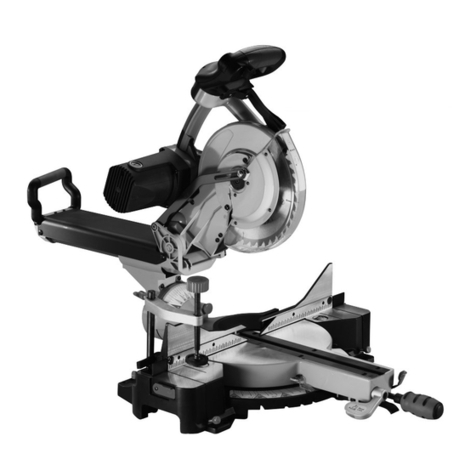
Scheppach
Scheppach Capas 5 Original instruction manual
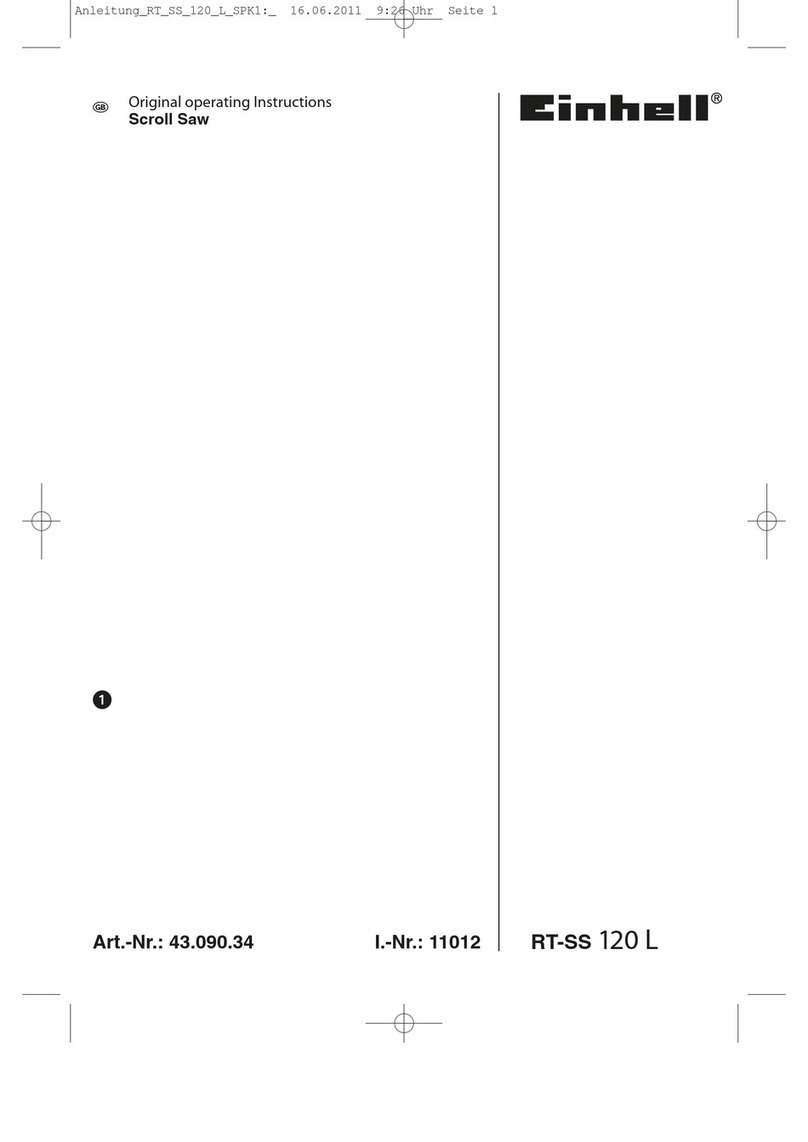
EINHELL
EINHELL RT-SS 120 L operating instructions

Craftsman
Craftsman 133.33166 Operator's manual
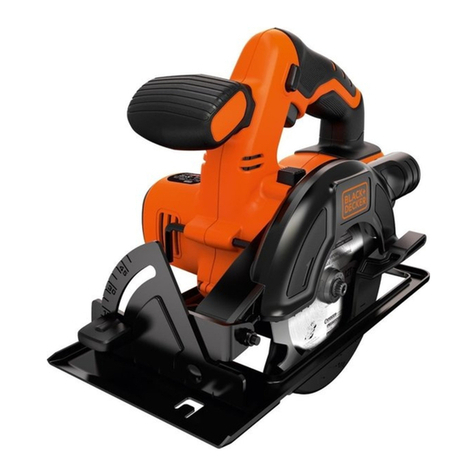
Black & Decker
Black & Decker BDCCS18 Original instructions
